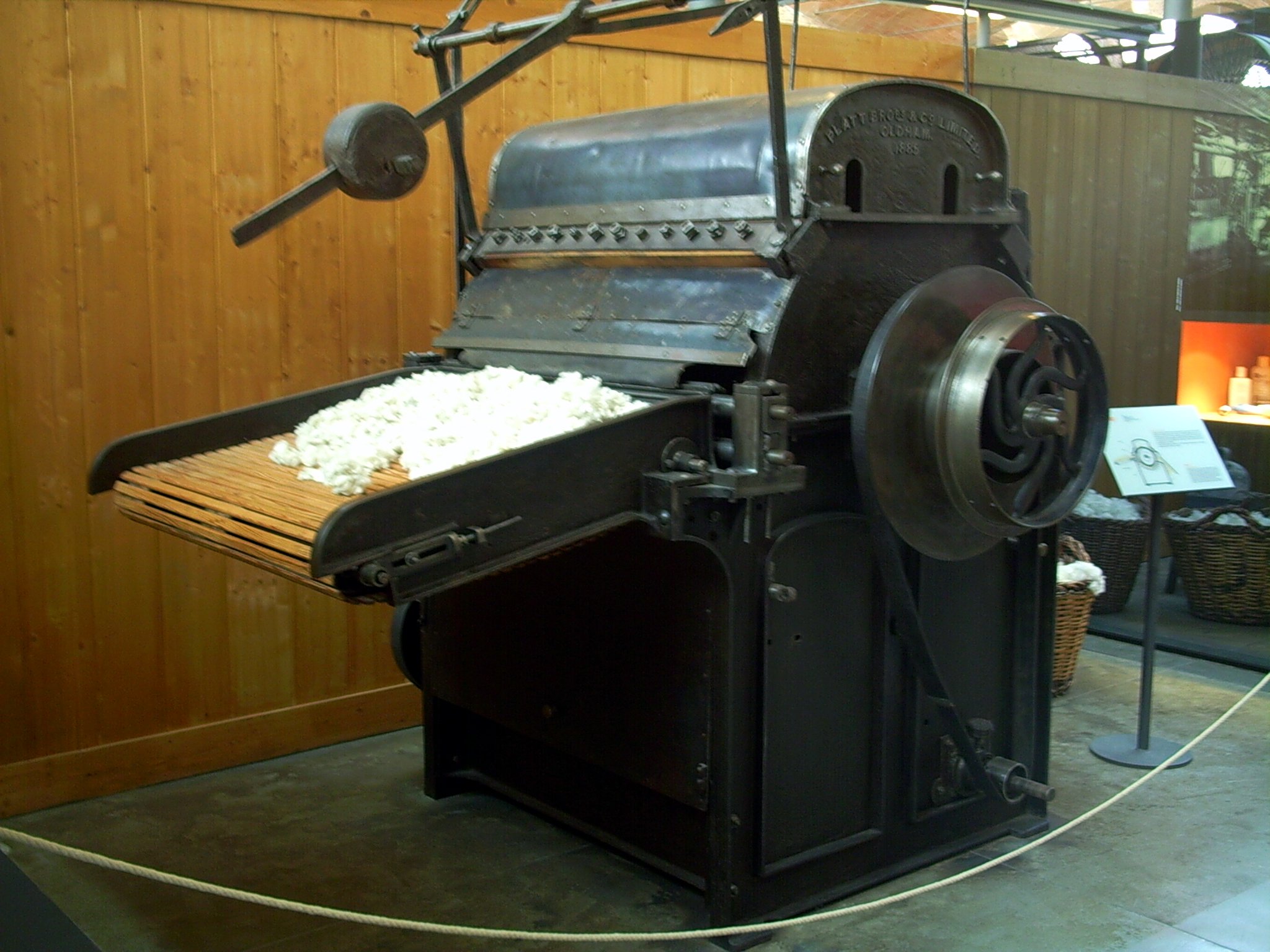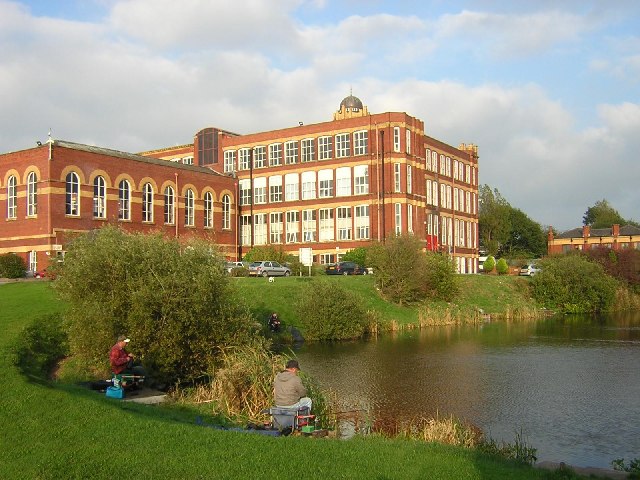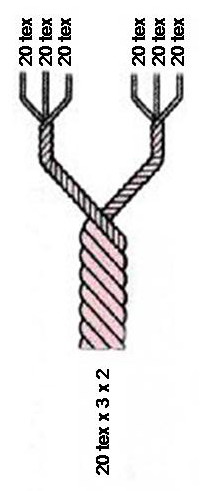|
Coppull Mill
Coppull Mill is a former cotton spinning mill in Coppull, Chorley, Lancashire. It was opened in 1906 by the Coppull Ring Spinning Co, followed by its sister mill, Mavis Mill in 1908. Together they employed 700 workers. The mill was taken over by the Lancashire Cotton Corporation in 1941 and passed to Courtaulds in 1964. The building is a Grade II listed building and is now used as an enterprise centre. This was a ring mill. It was driven by a 1600 hp triple-expansion four-cylinder engine by J & E Wood built in 1906. Its flywheel operated at 68 rpm and ran 36 ropes. Location Coppull is a village and civil parish in Lancashire, England. It is part of the Borough of Chorley, lies around above sea level and has a population of around 7,600. It is bounded by Whittle Brook, Clancutt Brook, the River Yarrow, Eller Brook, Hic-Bibi Brook and Stars Brook. Coppull is located between Chorley and Wigan, to the east of the A49 road near Charnock Richard. The village was 6 ... [...More Info...] [...Related Items...] OR: [Wikipedia] [Google] [Baidu] |
Coppull, Chorley, Lancashire
Coppull is a village and civil parish in Lancashire, England. It is part of the Borough of Chorley, lies around above sea level. Its population is around 8,000, having been counted at 7,959 in the 2011 Census. It is bounded by Whittle Brook, Clancutt Brook, the River Yarrow, Eller Brook, Hic-Bibi Brook and Stars Brook. Coppull is located between Chorley and Standish, Greater Manchester, to the east of the A49 road near Charnock Richard. History It is possible that a Roman road between Wigan and Walton-le-Dale passed over Coppull Moor according to the Chorley and District Historical and Archaeological Society after excavating a site there in 1959 and 1985. The settlement has an Anglo Saxon name describing its topography derived from the Old English ''copp'' a hill top and ''hyll'' a hill. The township was variously recorded as Cophull and Cophulle in 1277, Copphull in 1351, Copthull in 1374 and Coppull from 1444. The township was originally held by the lords of Worthington ... [...More Info...] [...Related Items...] OR: [Wikipedia] [Google] [Baidu] |
Charnock Richard
Charnock Richard is a small village and civil parish in the borough of Chorley, Lancashire, in England. The population of the civil parish taken at the 2011 census was 1,748. History The village was named in the early 13th century by the local landowner, who gave the township his first name of Richard, to distinguish it from neighbouring Heath Charnock. The village is situated on the A49 road which leads from Preston to Wigan. The manor house Park Hall dates from the 10th century. It was the home of Henry de Lea, who was beheaded with Adam Banastre on Leyland Moor in 1315, after the abortive Banastre Rebellion. Local amenities Charnock Richard Pasture is just off Freemans Lane, and is a Site of Special Scientific Interest. Charnock Richard Services, probably the area's most famous landmark, is a motorway service station, between Junctions 27 and 28 of the M6 Motorway. It was the first service station on the M6 when it opened in 1963 and is operated by Welcome Break. Next ... [...More Info...] [...Related Items...] OR: [Wikipedia] [Google] [Baidu] |
Buildings And Structures In The Borough Of Chorley
A building, or edifice, is an enclosed structure with a roof and walls standing more or less permanently in one place, such as a house or factory (although there's also portable buildings). Buildings come in a variety of sizes, shapes, and functions, and have been adapted throughout history for a wide number of factors, from building materials available, to weather conditions, land prices, ground conditions, specific uses, prestige, and aesthetic reasons. To better understand the term ''building'' compare the list of nonbuilding structures. Buildings serve several societal needs – primarily as shelter from weather, security, living space, privacy, to store belongings, and to comfortably live and work. A building as a shelter represents a physical division of the human habitat (a place of comfort and safety) and the ''outside'' (a place that at times may be harsh and harmful). Ever since the first cave paintings, buildings have also become objects or canvasses of much artist ... [...More Info...] [...Related Items...] OR: [Wikipedia] [Google] [Baidu] |
Textile Mills In Lancashire
Textile is an umbrella term that includes various fiber-based materials, including fibers, yarns, filaments, threads, different fabric types, etc. At first, the word "textiles" only referred to woven fabrics. However, weaving is not the only manufacturing method, and many other methods were later developed to form textile structures based on their intended use. Knitting and non-woven are other popular types of fabric manufacturing. In the contemporary world, textiles satisfy the material needs for versatile applications, from simple daily clothing to bulletproof jackets, spacesuits, and doctor's gowns. Textiles are divided into two groups: Domestic purposes onsumer textilesand technical textiles. In consumer textiles, aesthetics and comfort are the most important factors, but in technical textiles, functional properties are the priority. Geotextiles, industrial textiles, medical textiles, and many other areas are examples of technical textiles, whereas clothing and f ... [...More Info...] [...Related Items...] OR: [Wikipedia] [Google] [Baidu] |
Textile Mills Owned By The Lancashire Cotton Corporation
Textile is an umbrella term that includes various fiber-based materials, including fibers, yarns, filaments, threads, different fabric types, etc. At first, the word "textiles" only referred to woven fabrics. However, weaving is not the only manufacturing method, and many other methods were later developed to form textile structures based on their intended use. Knitting and non-woven are other popular types of fabric manufacturing. In the contemporary world, textiles satisfy the material needs for versatile applications, from simple daily clothing to bulletproof jackets, spacesuits, and doctor's gowns. Textiles are divided into two groups: Domestic purposes onsumer textilesand technical textiles. In consumer textiles, aesthetics and comfort are the most important factors, but in technical textiles, functional properties are the priority. Geotextiles, industrial textiles, medical textiles, and many other areas are examples of technical textiles, whereas c ... [...More Info...] [...Related Items...] OR: [Wikipedia] [Google] [Baidu] |
Cotton Mill
A cotton mill is a building that houses spinning (textiles), spinning or weaving machinery for the production of yarn or cloth from cotton, an important product during the Industrial Revolution in the development of the factory system. Although some were driven by animal power, most early mills were built in rural areas at fast-flowing rivers and streams using water wheels for power. The development of viable Watt steam engine, steam engines by Boulton and Watt from 1781 led to the growth of larger, steam-powered mills allowing them to be concentrated in urban mill towns, like Manchester, which with neighbouring Salford, Greater Manchester, Salford had more than 50 mills by 1802. The mechanisation of the spinning process in the early factories was instrumental in the growth of the machine tool industry, enabling the construction of larger cotton mills. Joint stock company, Limited companies were developed to construct mills, and the trading floors of the Manchester Royal Excha ... [...More Info...] [...Related Items...] OR: [Wikipedia] [Google] [Baidu] |
Textile Manufacturing
Textile Manufacturing or Textile Engineering is a major industry. It is largely based on the conversion of fibre into yarn, then yarn into fabric. These are then dyed or printed, fabricated into cloth which is then converted into useful goods such as clothing, household items, upholstery and various industrial products. Different types of fibres are used to produce yarn. Cotton remains the most widely used and common natural fiber making up 90% of all-natural fibers used in the textile industry. People often use cotton clothing and accessories because of comfort, not limited to different weathers. There are many variable processes available at the spinning and fabric-forming stages coupled with the complexities of the finishing and colouration processes to the production of a wide range of products. History Textile manufacturing in the modern era is an evolved form of the art and craft industries. Until the 18th and 19th centuries, the textile industry was a household ... [...More Info...] [...Related Items...] OR: [Wikipedia] [Google] [Baidu] |
Listed Buildings In Coppull
Coppull is a civil parish in the Borough of Chorley, Lancashire, England. It contains nine buildings that are recorded in the National Heritage List for England as designated listed buildings, all of which are listed at Grade II. This grade is the lowest of the three gradings given to listed buildings and is applied to "buildings of national importance and special interest". The parish contains the village of Coppull and surrounding farmland. Six of the listed buildings are, or originated as, farmhouses or farm buildings. The others are a former cotton spinning mill, its office, and the parish church of St John the Divine John of Patmos (also called John the Revelator, John the Divine, John the Theologian) is the name traditionally given to the author of the Book of Revelation. The text of Revelation states that John was on Patmos, a Greek island where, according .... Buildings References Citations Sources * * * * * * * * * * * * {{DEFAULTSORT:Coppull ... [...More Info...] [...Related Items...] OR: [Wikipedia] [Google] [Baidu] |
Bank Of England
The Bank of England is the central bank of the United Kingdom and the model on which most modern central banks have been based. Established in 1694 to act as the English Government's banker, and still one of the bankers for the Government of the United Kingdom, it is the world's eighth-oldest bank. It was privately owned by stockholders from its foundation in 1694 until it was nationalised in 1946 by the Attlee ministry. The Bank became an independent public organisation in 1998, wholly owned by the Treasury Solicitor on behalf of the government, with a mandate to support the economic policies of the government of the day, but independence in maintaining price stability. The Bank is one of eight banks authorised to issue banknotes in the United Kingdom, has a monopoly on the issue of banknotes in England and Wales, and regulates the issue of banknotes by commercial banks in Scotland and Northern Ireland. The Bank's Monetary Policy Committee has devolved responsibi ... [...More Info...] [...Related Items...] OR: [Wikipedia] [Google] [Baidu] |
Cotton Count
Textile fibers, threads, yarns and fabrics are measured in a multiplicity of units. * A fiber, a single filament of natural material, such as cotton, linen or wool, or artificial material such as nylon, polyester, metal or mineral fiber, or man-made cellulosic fibre like viscose, Modal, Lyocell or other rayon fiber is measured in terms of linear mass density, the weight of a given length of fiber. Various units are used to refer to the measurement of a fiber, such as: the denier and tex (linear mass density of fibers), super S (fineness of wool fiber), worsted count, woolen count, linen count (wet spun) (or Number English (Ne)), cotton count (or Number English (Ne)), Number metric (Nm) and yield (the reciprocal of denier and tex). * A yarn, a spun agglomeration of fibers used for knitting, weaving or sewing, is measured in terms of cotton count and yarn density. * Thread, usually consisting of multiple yarns plied together producing a long, thin strand used in sewing o ... [...More Info...] [...Related Items...] OR: [Wikipedia] [Google] [Baidu] |
Ring Spinning
Ring spinning is a spindle-based method of spinning fibres, such as cotton, flax or wool, to make a yarn. The ring frame developed from the throstle frame, which in its turn was a descendant of Arkwright's water frame. Ring spinning is a continuous process, unlike mule spinning which uses an intermittent action. In ring spinning, the roving is first attenuated by using drawing rollers, then spun and wound around a rotating spindle which in its turn is contained within an independently rotating ring flyer. Traditionally ring frames could only be used for the coarser counts, but they could be attended by semi-skilled labour. History Early machines * The Saxony wheel was a double band treadle spinning wheel. The spindle rotated faster than the traveller in a ratio of 8:6, drawing was done by the spinners fingers. *The water frame was developed and patented by Arkwright in the 1770s. The roving was attenuated (stretched) by draughting rollers and twisted by winding it onto a spin ... [...More Info...] [...Related Items...] OR: [Wikipedia] [Google] [Baidu] |
List Of Collieries In Lancashire Since 1854
The Lancashire Coalfield was one of the most prolific in England. The number of shafts sunk to gain coal number several thousand, for example, in 1958, Wigan undertook a survey of old shafts and located 500. In 1995 following several years of redevelopment across the Wigan Metropolitan Borough by the British Geological Survey (BGS), in association with the planning consultants Roger Tym & Partners, the list had grown to over 1000 with no real idea of the total. Similar surveys in Bolton and Manchester have also produced long lists of undocumented shafts. The proliferation of mines resulted from its accessibility at the start of the Industrial Revolution and the climate which was ideal for cotton mills. Coal fed the boilers of the cotton mill towns of Ashton-under-Lyne, Blackburn, Bolton, Burnley, Bury, Darwen, Oldham and Rochdale as well as the Rossendale Valley. The first industrial revolution coal mines supplied coal locally and to Liverpool, along the River Mersey via the Sa ... [...More Info...] [...Related Items...] OR: [Wikipedia] [Google] [Baidu] |







